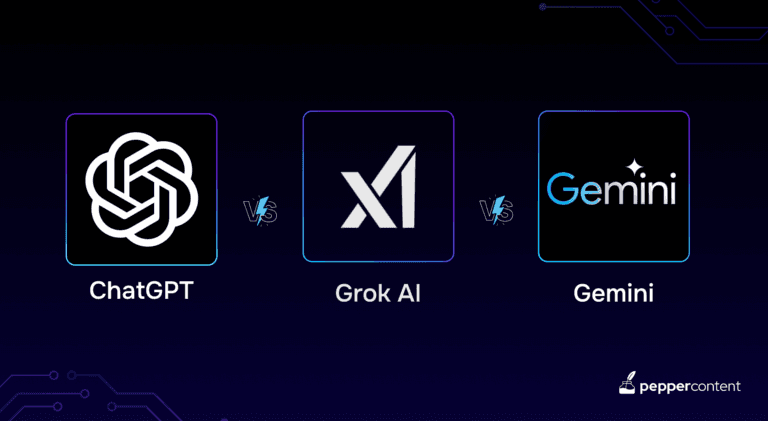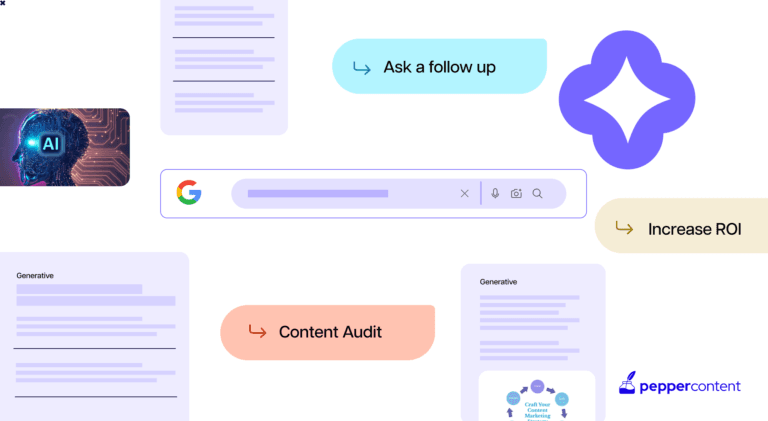Using AI to Transform Content Templates: A Comprehensive Guide

There is a lot of noise about how AI will soon rob people of their jobs, taking away the means to their livelihoods. However, when wielded in the right hands, this powerful tool can help us beyond our wildest imagination.
Content creation, which is often a challenging task for marketing teams, can also be simplified using AI. Wondering how? By creating content templates.
In this blog, we’ll take a deeper look into content templates and explore how AI can transform these templates for us. Let’s get started!
All About Content Templates
If you’ve ever worked in the content industry, regardless of whatever your role was, you’d be familiar with content templates. These are documents that lay down every piece of information a writer might need in order to create content that meets the objective of the marketing strategy.
But why do writers need such an elaborate document to create content? Because in order to create authentic content that appeals to its readers and stands out in the crowd of the internet, a content writer needs more information than merely a topic.
Content templates tell writers who their target audience is, the core message to be conveyed, the logical flow to be followed, and so on. In other words, they simplify the process of content creation, meanwhile ensuring that the end result meets the readers’ – as well as the business’s – expectations.
What to include in a content template?
Content templates offer a wide range of information that a writer will need while curating content. If you’re wondering what kind of information we are talking about here, the answer to your query lies below.
For those who are building a content template for the first time, here are some suggestions about the sections you include in it:
- Starting with the instructions
This might come as a surprise to some of you, but most content templates are usually larger than the content itself. Yes, we’re absolutely serious.
At times, these templates can appear too complex to navigate through for content writers. To avoid this, it’s best to begin your content creation template with a concise set of instructions about using it.
It’ll also be helpful to add a quick video guide for the same.
- The target audience and objective
The first thing that every writer needs to know before creating content – besides the topic – is about its potential reader.
To create content that speaks to them resonates with them, and encourages them to take action, you’d first need to understand who they are. It is only when you know about their lifestyle, interests, and challenges that you can align your content to address their pain points most efficiently.
Another important detail a writer needs starting out is the objective of the content. You need to tell them what the business wishes to achieve from their content; is it to create awareness about a certain product or service? Or is it to establish your industry expertise?
Knowing the end goal right from the start can help the writers give the right direction to the flow of content, highlighting the objective in a striking manner.
Here’s an example of how you can create a coherent and concise objective in your template:
- Timeline, length, and format
Every successful content marketing strategy includes a content calendar, which ensures a steady and consistent flow of content. To make sure your content delivery is timely, it is essential to provide the writers with a deadline.
Note that this deadline should be set well before the final date of publishing. This is because there are several other steps in content creation that come after writing – such as editing, designing, and so on.
While setting your deadline, you have to make sure that enough time is allotted for all content creation processes, including rework or revision if required.
The targeted word count of the content is another detail you should mention in the beginning. You also need to tell them about the format of the content. Is it a blog or a long-form article? A review report or a case study?
Different content formats follow different structures, serve different purposes, and use different delivery methods. There should be no room for confusion for the writers here.
- Tone and voice
Once the writers have learned about their target audience, deadline, and content type and length, tell them about the tone and voice their content needs to reflect.
But what is the tone, and how is it decided? Well, the objective of the content (that we talked about earlier) plays a key role in it. Content can be educative, persuasive, entertaining, or inspiring in nature. It is this nature that sets the tone of the content.
Voice varies with the nature of the content as well. An active voice is preferred in conversational content formats like blogs and articles. On the other hand, the more formal content formats – like academic, technical, or report writing – prefer the usage of passive voice.
The picture below is a perfect example of how you can define the tone and voice of the content in your content audit template:
- SEO guidelines (Keywords, meta details, and more)
It is no secret that only well-optimized content is discoverable to your readers on search engines. Therefore, the SEO guide is a vital section of your content template, where you provide the writer with high-ranking keywords that you want to be integrated into the content.
Here’s an example of how that’s done:
Keywords alone are not going to affect the SERP ranking of your content. You also need to optimize your meta title and description, practice internal and external linking, and use other media (images, videos, etc.) in order to rank on top. Therefore, you should always be thorough and inclusive with your SEO guidelines.
- Defining the conclusion
The conclusion of the content is its most crucial section because it’s where you can ask your readers to take action. This action could be signing up for your newsletters, subscribing to your services, or purchasing your product.
A clearly-defined conclusion could prove to be a game-changer for your marketing. This is why you should be as clear about it in your content template as possible.
Take a look at an example of how to create a concluding section in your content template below:
How can AI Transform your Content Templates?
As you have gathered by now, content templates can simplify the content creation process significantly. But when you have a large business, creating content templates alone becomes a tedious and exhausting task.
This is where Artificial Intelligence comes in. Powered by Natural Language Generation (NLG) and Natural Language Processing (NLP) models, an AI tool can not only perceive human perspective but also attempt to imitate it.
You can also use artificial intelligence to generate detailed content templates or even content audit templates and content creation templates for your business. It will do all the research and analysis to come up with an inclusive and comprehensive content template, thereby saving both the time and effort of your content marketing team.
Peppertype.ai: A One-stop Solution to all your Content Needs
Content templates can do wonders in simplifying the job of your writers. If you don’t have the time to create them, Peppertype.ai is here to lend a hand!
This AI-powered tool can not just create a template for your content but also help in analyzing its performance once it goes live. To know how else can our content marketing platform fulfill the content needs of your business, visit us here!
FAQs
A content strategist is the one who creates a brief template, while the content writer uses it to produce content. The role of the former involves is to analyze the content marketing strategy and ensure that its vision and goals are met through the content. This is why they form content templates for the writers.
On the other hand, the job of the content writer is to produce creative, authentic, relevant, and optimized content based on the guidelines they receive.
Yes, it is. Using a content marketing automation platform can not only streamline all your marketing efforts but also provides a higher ROI.
To pick the right automation platform for your business, here are a few things you need to look for:
1. Usability
2. Integration with existing tools
3. Scalability
4. Customization
5. Research and Analytics
Latest Blogs
Explore how Google’s 2025 AI search updates triggered ranking chaos. Learn actionable strategies to adapt your SEO for AI Overviews, zero-click searches, and SERP volatility. Stay ahead now.
Learn how to rank on AI search engines like ChatGPT, Perplexity, and Gemini by optimizing your content for authority, structure, and relevance. Stay ahead in AI-driven search with this strategic guide.
Explore the best healthcare SEO services for your medical practice. Improve online visibility and effectively reach more patients in need of your services.
Get your hands on the latest news!
Similar Posts

Generative AI
8 mins read
Top 5 Rules to Rule AI Marketing Tools Like a Pro

Generative AI
8 mins read
ChatGPT vs Grok AI vs Gemini AI: Everything You Need to Know About These Powerful AI Assistants

Generative AI
8 mins read